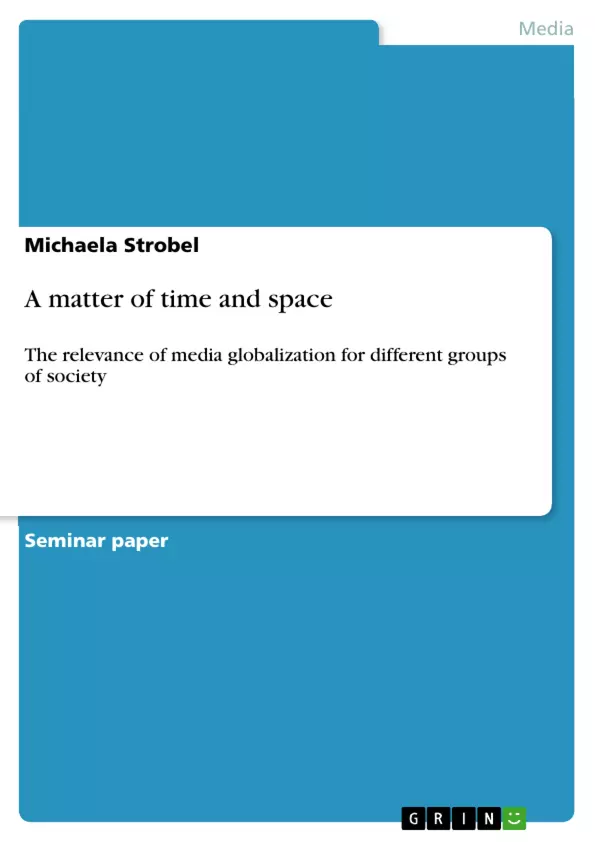[...]
Whether something is a myth or not, is hard to define as the perception of a myth – the evaluation if a certain situation is exaggerated or not (Hafez 2007: 1) – is always something very subjective and depending on the judge’s viewpoint. So it is not surprising that in his book Kai Hafez comes to the conclusion that media globalization is a myth. He links strict requirements1 to the state of globalization and seems to be analyzing mainly German media products under this perspective. He is also largely focusing on the receiving end of media content – the spectator (Hafez 2007: 14) – and emphasizing the role of the medium television within the globalization debate. Although the comparatively minor role the internet plays in this work could be due to the fact that this medium first started its unprecedented exponential grow around 20072. Nevertheless he is neither emphasizing qualitative data to confirm his assumptions of a non-globalized media audience, nor is he presenting a broad range of quantitative figures to support his conclusion of a lack of globalization in the structure of media industry, policy and distribution. Although Hafez is referring to globalization as a process (Hafez 2007: 23), his high expectations of system change (Hafez 2007: 2) are leading to the rather utopian idea of the final state of a entirely globalized world – a situation which he describes has already happened in other sectors, such as economy of industrial goods (Hafez 2007: 4). Especially when dealing with such an all-encompassing question as globalization, it is crucial to dare a glimpse out of the box, not letting one-self be deluded by the West-European media culture one was born into and the wishful thinking of an ideal state of globalism, where all media content is accepted equally among the world’s public (Hafez 2007: 12). In order to challenge such a human terminology like ‘myth’ I consider it appropriate to look at the phenomenon of globalization and media at eye level with the human part of media –its users3. By doing this, the following text will clearly reveal that Hafez’s ‘myth’ isn’t actually reality.
[...]
Inhaltsverzeichnis (Table of Contents)
- Introduction
- Goal of this paper and approach to the topic.
- Globalization concepts as stencil for media
- Analyzing media..
- Outside polito-economical framework
- Inside temporal-spatial constitution of content.
- Media impact on a global scale
- The everyman recipient.....
- Migrants.
- Hybrids...
- Cosmopolitans
- Conclusion......
Zielsetzung und Themenschwerpunkte (Objectives and Key Themes)
This research paper aims to challenge the notion that media globalization is a myth, as argued by Kai Hafez in his book “The myth of media globalization.” The paper examines Hafez’s arguments by analyzing the global media landscape from the perspective of the user, considering both the external framework of society and the internal structure of media content. Key themes explored in the paper include: * **The role of technology in shaping globalization**: The paper acknowledges the impact of technological advancements, such as the internet and satellite television, in driving global media interconnectedness. * **The impact of media on different groups**: The paper examines the influence of globalized media on various groups, including the average recipient, migrants, cosmopolitans, and cultural hybrids. * **The limitations of a “super system” approach**: The paper critiques the assumption that globalization leads to a uniform, global media system, highlighting the continued importance of local context and cultural diversity. * **The need for a holistic understanding of media globalization**: The paper advocates for an examination of media globalization beyond economic and political factors, incorporating a deeper analysis of cultural influences and user perspectives. * **The significance of user agency**: The paper emphasizes the active role of media users in shaping and interpreting global media content, moving beyond the traditional notion of a passive audience.Zusammenfassung der Kapitel (Chapter Summaries)
Introduction
This chapter introduces the central argument of the paper, challenging Kai Hafez’s claim that media globalization is a myth. The paper outlines its approach, which involves examining Hafez’s arguments within a broader framework of globalization theory and then focusing on the impact of global media on different groups of users.Globalization Concepts as Stencil for Media
This chapter explores various theories of globalization, highlighting its key characteristics, including technological change, increasing interconnectedness, and the influence of global events on local contexts. The chapter argues that globalization is a complex and uneven process, characterized by both interconnectedness and local transformation.Analyzing Media: Outside Polito-Economical Framework
This chapter examines the global media landscape beyond traditional economic and political perspectives. It explores the role of transnational corporations, satellite television, and the internet in creating a globally interconnected media system. The chapter discusses the rapid growth of global media trade and the increasing availability of media content across the globe.Analyzing Media: Inside Temporal-Spatial Constitution of Content
This chapter focuses on the internal structure of media content, examining how the temporal and spatial dimensions of media influence its meaning and impact. The chapter explores how media narratives can both reflect and shape global realities.Schlüsselwörter (Keywords)
The key terms and concepts examined in this paper include media globalization, globalization theory, transnational media corporations, global media infrastructure, digital divide, media users, cultural hybridity, cosmopolitanism, and the myth of media globalization. The paper explores the complex interplay between these concepts, ultimately challenging the idea that media globalization is a myth and arguing for a more nuanced understanding of its influence on different groups within society.- Quote paper
- Michaela Strobel (Author), 2012, A matter of time and space, Munich, GRIN Verlag, https://www.grin.com/document/204117



